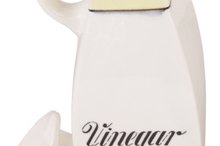Natural Witch Hazel for Yeast Infections
Yeast infections are caused by various species of fungus. The most common culprit is Candida albicans, which can proliferate in people with weakened immune systems or unbalanced internal flora and fauna. Candida yeasts prefer warm, moist areas of the body, such as the vagina and underneath the breasts. If left untreated, yeast infections can spread throughout the body and become toxic. Localized yeast infections can be treated with anti-fungal drugs, although some people prefer natural antiseptics, such as witch hazel, because they produce fewer side effects.
If you are experiencing serious medical symptoms, seek emergency treatment immediately.
Causes of Yeast Infections
A primary cause of yeast infections is a weakened immune system, which allows the microbes to proliferate relatively unchecked. Immunity can become weakened by diseases, such as AIDS and cancer, or from their treatments, such as antiviral drugs and chemotherapy. Chronic stress, malnourishment and sleep deprivation can also hamper immune function. Other common causes of yeast infections include poor hygiene, overuse of antibiotics, long-term use of birth control pills and poor dietary choices.
- A primary cause of yeast infections is a weakened immune system, which allows the microbes to proliferate relatively unchecked.
Yeast Infections of the Vagina
How to Get Rid of Vaginal Odor Without Going to the Doctor
Learn More
The most common yeast infection in women occurs within the vagina and is caused by Candida albicans. The book, “Fungal Infection: Diagnosis and Management,” notes that about three-quarters of American women experience a vaginal yeast infection and almost half experience multiple infections during their lifetimes 3. Vaginal yeast infections can be triggered by sexual relations, pregnancy, gynecological procedures and bacterial infections.
Benefits of Witch Hazel
Witch hazel grows as a shrub-like tree and produces leaves and bark that have antiseptic properties. Witch hazel contains tannic acid, which acts as a powerful astringent, is able to dry the skin out quickly upon contact. According to “The Essential Book of Herbal Medicine,” witch hazel also contains carvacol and eugenol, which are oils that display strong antimicrobial properties 4. Being able to kill both bacteria and yeast is important because vaginal yeast infections sometimes co-exist with bacterial infections. Witch hazel can be distilled and made into oils, ointments and extracts.
- Witch hazel grows as a shrub-like tree and produces leaves and bark that have antiseptic properties.
Methods of Witch Hazel Use
Garlic Treatment for Warts
Learn More
Witch hazel extract can be added to distilled water to make an astringent solution and used in a vaginal douche. This makes a safe and affordable internal cleanse that can be done daily. The same solution could be used as a rinse for infections of the mouth, called oral thrush. However, swallowing it may cause stomach or intestinal irritation. Witch hazel oils can be added to bath water, which is less effective for vaginal yeast infections, but appropriate for skin infections. For quick relief of itchiness, witch hazel ointment can be added to compress and dabbed externally to the affected area.
- Witch hazel extract can be added to distilled water to make an astringent solution and used in a vaginal douche.
Related Articles
References
- “Professional Guide to Diseases: Ninth Edition”; Springhouse Publishing; 2009
- “Human Biochemistry and Disease”; Gerald Litwack; 2008
- “Fungal Infection: Diagnosis and Management, 3rd Edition”; Richardson and Warnock; 2003
- “The Essential Book of Herbal Medicine”; Simon Mills; 1994
- Chevallier, A. Encyclopedia of Herbal Medicine: 550 Herbs and Remedies for Common Ailments. New York, NY: DK Publishing; 2016.
- Wolff HH, Kieser M. Hamamelis in children with skin disorders and skin injuries: results of an observational study. Eur J Pediatr. 2007;166(9):943-8. doi:10.1007/s00431-006-0363-1
- Li, CS. Medicinal Plants: Culture, Utilization and Phytopharmacology. New York, NY: Taylor & Francis; 2000.
- Hayes, E, McCuiston, LE, Kee, J. Pharmacology: A Patient-Centered Nursing Process Approach. New York, NY: Elsevier Health Sciences; 2014.
- Balch, PA. Prescription for Herbal Healing. New York, NY: Avery Publishing; 2002.
- Cosmetic Ingredient Review. Safety Assessment of Hamamelis virginiana (Witch Hazel)-Derived Ingredients as Used in Cosmetics. Washington, DC: Cosmetic Ingredient Review; 2017.
- Choi HR, Choi JS, Han YN, et al. Peroxynitrite Scavenging Activity of Herb Extracts. Phytother Res. 2002;16(4):364-7. doi: 10.1002/ptr.904
- Lizárraga D, Touriño S, Reyes-Zurita FJ, et al. Witch Hazel (Hamamelis virginiana) Fractions and the Importance of Gallate Moieties—Electron Transfer Capacities in Their Antitumoral Properties. J Agric Food Chem. 2008;56(24):11675-82. doi: 10.1021/jf802345x.
- Reuter J, Wölfle U, Korting HC, Schempp C. Which Plant for Which Skin Disease? Part 2: Dermatophytes, Chronic Venous Insufficiency, Photoprotection, Actinic Keratoses, Vitiligo, Hair Loss, Cosmetic Indications. J Dtsch Dermatol Ges. 2010;8(11):866-73. doi: 10.1111/j.1610-0387.2010.07472.x.
- Touriño S, Lizárraga D, Carreras A, et al. Highly Galloylated Tannin Fractions From Witch Hazel (Hamamelis virginiana) Bark: Electron Transfer Capacity, in Vitro Antioxidant Activity, and Effects on Skin-Related Cells. Chem Res Toxicol. 2008;21(3):696-704.
- Wang H, Provan GJ, Helliwell K. Determination of Hamamelitannin, Catechins and Gallic Acid in Witch Hazel Bark, Twig and Leaf by HPLC. J Pharm Biomed Anal. 2003;33(4):539-44.
- Wolff HH, Kieser M. Hamamelis in Children With Skin Disorders and Skin Injuries: Results of an Observational Study. Eur J Pediatr. 2007;166(9):943-8. doi: 10.1007/s00431-006-0363-1
Writer Bio
Owen Bond began writing professionally in 1997. Bond wrote and published a monthly nutritional newsletter for six years while working in Brisbane, Australia as an accredited nutritionalist. Some of his articles were published in the "Brisbane Courier-Mail" newspaper. He received a Master of Science in nutrition from the University of Saskatchewan.








